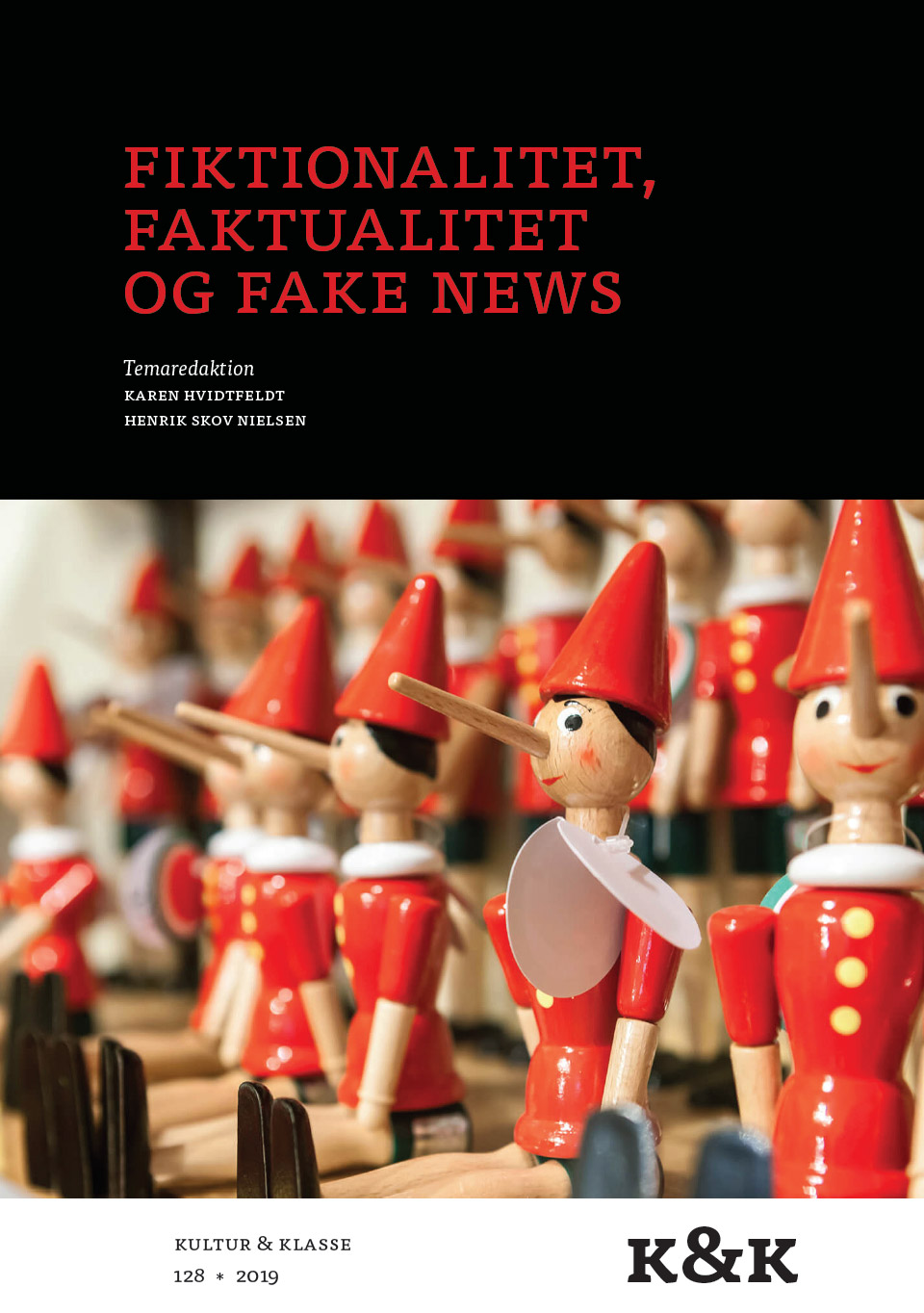Litteraturkritik, fankultur og affekt: Trump og Pynchons konspirationslæsere
Trump og Pynchons konspirationslæsere
DOI:
https://doi.org/10.7146/kok.v47i128.118033Nøgleord:
Donald Trump, Thomas Pynchon, USA, konspirationsteori, kulturstudier, fanstudier, litteraturkritik, tekstanalyseResumé
This article outlines the two cultures in the study of conspiracy culture, where social science disciplines provide one type of approach and cultural studies another. To make a claim for recovering the use of literature in the field, both to bridge the divide, if possible, and to suggest new critical directions for literary studies itself, the article offers a reading of two congruent conspiracy narrations, Donald Trump’s rhetoric and Thomas Pynchon’s novels. Both are examples of ambiguous narration, which may be taken at face value by one reader and invested with hidden significance by another, thus creating two closed-off epistemic bubbles – politically and critically. When critics have not been taking conspiracy fans, which could include esteemed literary figures like Pynchon, seriously, they have been guilty of closed reading. Fans themselves, though equally closed readers technically, offer avenues into affective and co-creative conspiracy readings which are, paradoxically, open to the reparative possibilities literature can have in a politically paranoid society.
Referencer
Benea, Diana. The Political Imagination of Thomas Pynchon’s Later Novels. Bucharest: Ars Docendi - University of Bucharest Press, 2017.
Bjerre-Poulsen, Niels. ”Conspiracy Theory in the USA”. Forelæsning, 1. november 2006.
Butter, Michael og Peter Knight. ”Bridging the Great Divide: Conspiracy Theory Research for the 21st Century”. Diogenes, 2016, doi: https://doi.org/10.1177/0392192116669289.
Colbert, Stephen. ”Stephen Colbert”. Interview med Nathan Rabin, 25. januar 2006,
https://tv.avclub.com/stephen-colbert-1798208958.
Colbert, Stephen. ”The Wørd – Truthiness.” The Colbert Report, Comedy Central, 17. oktober 2005.
Conway, Kellyanne. ”Conway: Press Secretary Gave ‘Alternative Facts’”. Interview med Chuck Todd, Meet The Press, NBC, 22. januar 2017.
Cutbirth, Joe Hale. ”Satire as Journalism: The Daily Show and American Politics at the Turn of the Twenty-First Century”. Ph.D.-afhandling, Columbia University, 2011. doi:https://doi.org/10.7916/D8W66SQC.
Dalsgaard, Inger H. ”Conspiracy Reading: New Literary Perspectives on Paranoia in Thomas Pynchon”. Plots: Literary Form and Conspiracy Culture, red. Dana Crăciun et al., London: Routledge, 2020.
Dalsgaard, Inger H., red. Thomas Pynchon in Context. Cambridge: Cambridge University Press, 2019.
”The Psychology of Conspiracy Theories”. Current Directions in Psychological Science, 26 6 (2017): 538-542. doi:https://doi.org/10.1177/0963721417718261.
Erion, Gerald J. ”Amusing Ourselves to Death with Douglas, Karen M. et al. Television News: Jon Stewart, Neil Postman, and the Huxlyan Warning”. Common Culture : Reading and Writing About American Popular Culture. Red. Michael Petracca og Madeleine Sorapure, 7. udg. Pearson, 2012, 168-177. https://www.statsbiblioteket.dk/au/#/search?query=recordID%3A%22sb_5505930%22.
Freer, Joanna. Thomas Pynchon and American Counterculture.Cambridge: Cambridge University Press, 2014. Cambridge Studies in American Literature and Culture. 169.
Glynn, Alan. ”Conspiracy Fiction Once Helped Us Tell the Truth. Now It’s a Weapon for Liars”. New York Magazine, 4. januar 2019. https://www.vulture.com/2019/01/can-conspiracy-thrillers-work-under-a-conspiracy-presidency.html.
Herman, Luc og Steven Weisenburger. Gravity’s Rainbow, Domination, and Freedom. Athens: The University of Georgia Press, 2013.
Hollander, Charles. ”Pynchon, JFK and the CIA: Magic Eye Views of The Crying of Lot 49”. Pynchon Notes.40-41 (Spring-Fall, 1997): 61-106. doi:http://doi.org/10.16995/pn.164.
Howard, Gerald. ”Pynchon from a to V.” Book Forum, 2005, https://www.bookforum.com/archive/sum_05/pynchon.html.
Iser, Wolfgang. ”Indeterminacy and the Reader’s Response in Prose Fiction”. Aspects of Narrative. Red. J. Hillis MiIller, English Institute Essays, 1971, 1-45. https://www-fulcrum-org.ez.statsbiblioteket.dk:12048/epubs/r494vk50j#/6/46[xhtml00000023]!/4/1:0.
Johnson, Jenna. ”‘A Lot of People Are Saying…’: How Trump Spreads Conspiracies and Innuendoes .” The Washington Post, 13 juni 2016. https://www.washingtonpost.com/politics/a-lot-of-people-are-saying-how-trump-spreads-conspiracies-and-innuendo/2016/06/13/b21e59de-317e-11e6-8ff7-7b6c1998b7a0_story.html?utm_term=.0e660af79ee9.
Jones, Jeffrey P. ”’Fake’ News Versus ’Real’ News as Sources of Political Information: The Daily Show and Postmodern Political Reality”. Common Culture : Reading and Writing About American Popular Culture. Red. Michael Petracca og Madeleine Sorapure, 7. udg. Pearson, 2012, 178-198. https://www.statsbiblioteket.dk/au/#/search?query=recordID%3A%22sb_5505930%22.
Knight, Peter. Conspiracy Culture: From the Kennedy Assassination to the X-Files. London: Routledge, 2000.
Knight, Peter og Alasdair Spark. ”Conspiracy Culture Conference”. http://www2.winchester.ac.uk/ccc/events/launchconference.htm.
Marchlewska, Marta et al. ”Addicted to Answers: Need for Cognitive Closure and the Endorsement of Conspiracy Beliefs”. European Journal of Social Psychology. 48 2 (2018): 109-117. doi:doi:10.1002/ejsp.2308.
Nicol, Bran. ”Reading Paranoia: Paranoia, Epistemophilia and the Postmodern Crisis of Interpretation”. Literature and Psychology. 45 1/2(1999): 44-62. http://gateway.proquest.com/openurl?ctx_ver=Z39.88-2003&xri:pqil:res_ver=0.2&res_id=xri:lion&rft_id=xri:lion:rec:mla:R03146003.
Pipes, Daniel. Conspiracy: How the Paranoid Style Flourishes and Where It Comes From. New York: The Free Press, 1997.
Prooijen, Jan-Willem van og Paul A. M. van Lange. Power, Politics, and Paranoia: Why People Are Suspicious of Their Leaders. Red. Jan-Willem van Prooijen og Paul A. M. van Lange,. Cambridge: Cambridge University Press, 2014.
Pynchon, Thomas. Gravity’s Rainbow. New York: Viking, 1973.
Pynchon, Thomas. Slow Learner. Boston: Little, Brown, 1984.
Rutenberg, Jim. ”In Trump’s Volleys, Echoes of Alex Jones’s Conspiracy Theories”. The New York Times, 19 februar 2017, 1B. https://www.nytimes.com/2017/02/19/business/media/alex-jones-conspiracy-theories-donald-trump.html.
Sedgwick, Eve Kosofsky. ”Paranoid Reading and Repetitive Reading, or, You’re So Paranoid, You Probably Think This Essay Is About You”. Touching Feeling : Affect, Pedagogy, Performativity. Red. Eve Kosofsky Sedgwick og Adam Frank,. Durham: Duke University Press, 2003, 123-151. https://www.statsbiblioteket.dk/au/#/search?query=recordID%3A%22sb_4467892%22.
Thomas, Samuel. Pynchon and the Political. New York: Routledge, 2007.
Whitson, Jennifer A. og Adam D. Galinsky. ”Lacking Control Increases Illusory Pattern Perception”. bd. 322, nr. 5898, 2008, 115-117, doi:https://doi.org/10.1126/science.1159845
Ziolkowski, Theodore. Lure of the Arcane: The Literature of Cult and Conspiracy. Baltimore: Johns Hopkins University Press, 2013.
Downloads
Publiceret
Citation/Eksport
Nummer
Sektion
Licens
Tidsskriftet følger dansk ophavsret.





